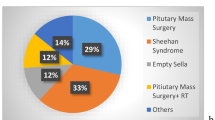Summary
Low levels of oestrogen, FSH and LH in serum have been reported in patients with gout. The mechanism by which sex hormones affect the development of gout is unknown, but some investigators believe that it is related to the influence of oestrogens on serum uric acid levels. We studied the relationship between serum uric acid and 17 beta oestradiol (ES) levels in asymptomatic hyperuricaemic (ASH) men in order to test the hypothesis that low ES levels are associated with hyperuricaemia. Thirty-eight men with asymptomatic hyperuricaemia (ASH) were selected from a population of healthy individuals undergoing periodical multiphasic health examinations. After adjusting for the differences in albumin levels between the two groups, no significant difference in serum ES level was found. The serum testosterone levels were similar in both groups. These findings suggest that there is no difference in the sex hormone profiles between asymptomatic hyperuricaemic and normouricaemic men.
Similar content being viewed by others
References
Hippocrates. Genuine Works of Hippocrates translated from the Greek with a preliminary discourse and notations by Francis Adams, Volumes I and II, London, Sydenham Society, 1849.
Braunwald, E. In: Harrison's Principles of Internal Medicine, 12th ed., Eds.: Wilson, J.D., Braunwald, E., Isselbacher, K.J., Petersdorf, R.G., Martin, J.B., Fauci, A.S., Root, R.K. New York, McGraw-Hill Inc., 1991, 1835.
Marinello, E., Riario-Sforzo, G., Marcolongo, R. Plasma follicle-stimulating hormone, luteinizing hormone and sex hormones in patients with gout. Arthritis Rheum 1985, 28, 127–131.
Puig, J.G., Mateos, F.A., Ramos, T.H., Capitan, C.F., Michan, A.A., Mantilla, J.M.G. Sex differences in uric acid metabolism in adults: evidence for a lack of influence of estradiol-17β [E2]. Adv Exp Med Biol 1986, 195, 317–323.
Lind, T., Godfrey, K.A., Otun, H. Changes in serum uric acid concentrations during normal pregnancy. Br J Ob Gyn 1984, 91, 128–132.
Mira, M., Stewart, P.M., Gebski, V., Llewellyn-Jones, D., Abraham, S.F. Changes in sodium and uric acid concentrations in plasma during the menstrual cycle. Clin Chem 1984, 30, 380–381.
Nicholls, A., Snaith, M.L., Scott, J.T. Effect of oestrogen therapy on plasma and urinary levels of uric acid. Brit Med J 1973, 1, 449–451.
Levinson, D.J., Chalker, D., Rat hepatic xanthine oxidase activity. Arthritis Rheum 1980, 23, 77–82.
Fessel, W.J., Siegelaub, A.B., Johnson, E.S. Correlates and consequences of asymptomatic hyperuricemia. Arch Intern Med 1973, 132, 44–54.
Bodel, P., Dillar, G.M. Jr., Kaplan, S.S., Malawista, S.E. Anti-inflammatory effects of estradiol on human blood leukocytes. J Lab Clin Med 1972, 80, 373–384.
Weissmann, G., Rita, G.A. Molecular basis of gouty inflammation: Interaction of monosodium urate crystals with lysosomes and lipisomes. Nature 1972, 240, 167–172.
Spilberg, I. Current concepts of the mechanism of acute inflammation in gouty arthritis. Arthritis Rheum 1975, 18, 129–134.
Steele, T.H. Asymptomatic hyperuricemia. Pathogenic or innocent bystander. Arch Intern Med 1979, 139, 24–25.
Campion, E.W., Glynn, R.J., DeLabry, L.O. Asymptomatic hyperuricemia. Risks and consequences in the normative aging study. Am J Med 1987, 82, 421–426.
Klinenberg, J.R., Bluestone, R., Schlosstein, L., Waissan, J., Whitehouse, L.M.W. Urate deposition disease. Ann Int Med 1973, 78, 99.
Aleo, F., Comande, S., Marcolongo, R., Marinello, E., Valentini, U. The hormonal regulation of purine biosynthesis: basal levels of different hormones in primary gout. Adv Exp Med Biol 1984, 165, 437–440.
Alvsaker, J.O. Uric acid in human plasma: III. Investigations on the interaction between the urate ion and human albumin. Scand J Clin Lab Invest 1965, 17, 467–475.
Fessel, W.J., Barr, G.D. Uric acid, lean body weight, and creatinine interactions: results from regression analysis of 78 variables. Sem Arthritis Rheum 1977, 7, 115–121.
Aubock, J., Fritsch, P. Asymptomatic hyperuricaemia and allopurinol induced toxic epidermal necrolysis. Brit Med J 1985, 290, 1969–1970.
Ganong, W.F. Review of Medical Physiology. California, Lange Medical Publication, 10th edotopm. 1981, p. 354.
Author information
Authors and Affiliations
Rights and permissions
About this article
Cite this article
Rosen, R., Tomer, Y., Carel, R. et al. Serum 17-beta-estradiol and testosterone levels in asymptomatic hyperuricaemic men. Clin Rheumatol 13, 219–223 (1994). https://doi.org/10.1007/BF02249015
Received:
Accepted:
Issue Date:
DOI: https://doi.org/10.1007/BF02249015




